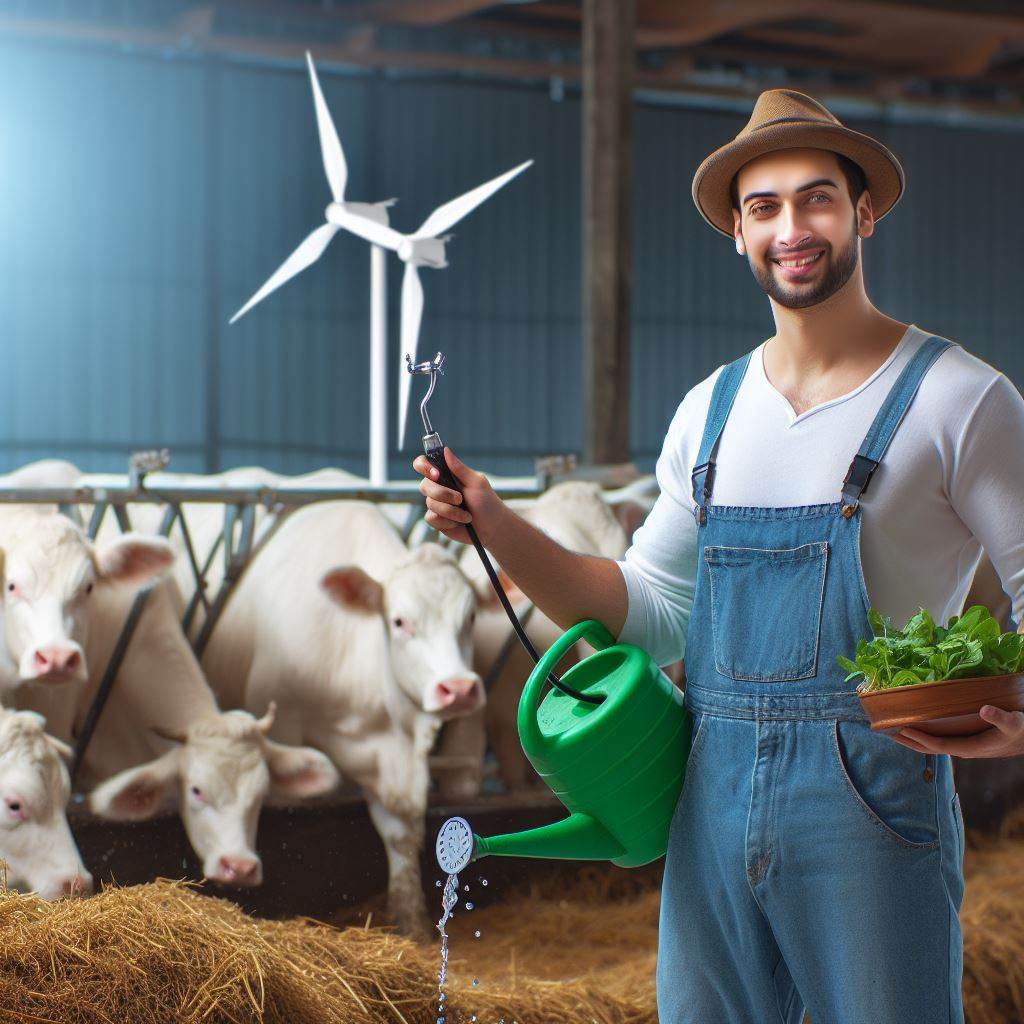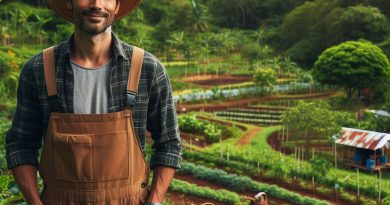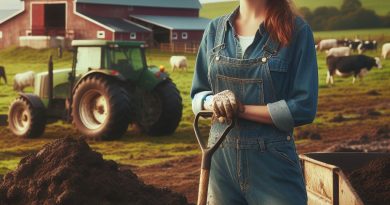Water Saving in Animal Farming
Last Updated on February 7, 2024
Introduction
Water is an essential resource in animal farming, requiring careful management to ensure sustainability and efficiency.
Water saving in animal farming is crucial to meet the increasing demands for food production while minimizing environmental impact.
Implementing sustainable practices in agriculture, including water-saving techniques, is necessary to preserve natural resources and promote long-term food security.
By using innovative methods, such as efficient watering systems and proper waste management, animal farmers can reduce water consumption.
Water-saving practices not only benefit the environment but also contribute to cost savings for farmers.
Effective irrigation systems, rainwater harvesting, and recycling can further optimize water use in animal farming.
Conserving water helps prevent water scarcity and supports the overall health and well-being of animals.
Implementing water-saving practices in animal farming is a responsible approach towards ensuring a sustainable and resilient food system.
Sustainable agriculture practices, including water conservation, align with societal expectations for ethical and environmentally friendly farming.
Water-saving practices in animal farming are essential for resource conservation, environmental protection, and long-term sustainable agriculture.
Current water usage in animal farming
Water is a precious resource, and its conservation is essential in all sectors, including animal farming.
Currently, water usage in animal farming is significant and requires attention.
Different types of animals have distinct water requirements, which must be taken into account.
The typical water requirements of different types of animals
Cattle, for example, are one of the largest consumers of water in the animal farming industry. A single dairy cow can consume up to 20 gallons of water per day.
In hot weather, this consumption can increase even further. Moreover, pigs also require a substantial amount of water, averaging 2-3 gallons per day.
Interestingly, poultry farming has relatively lower water requirements compared to cattle and pigs. Chickens, for instance, usually consume around 0.2 liters of water per day.
When considering the vast number of chickens raised in this industry, their water usage accumulates significantly.
Statistics on water usage in animal farming
In animal farming, water usage statistics raise concerns. According to a study, animal agriculture accounts for 20-33% of global water consumption.
In the United States alone, livestock watering represents 55% of the total water usage. These staggering numbers highlight the magnitude of the problem.
The potential environmental impact of excessive water usage
Excessive water usage in animal farming poses potential environmental impacts. One significant concern is the strain placed on local water resources.
As large quantities of water are diverted for animal consumption, it depletes local water supplies and affects ecosystems.
The overuse of water can lead to reduced water availability for other essential purposes such as human consumption and agriculture.
Excessive water usage contributes to water pollution. Animal waste, which often contains harmful substances, can contaminate nearby water sources through runoff.
This pollution poses risks to aquatic ecosystems and can harm both flora and fauna. Additionally, the energy consumed in treating and purifying contaminated water also contributes to environmental degradation.
To address these challenges, adopting water-saving practices in animal farming is crucial.
Implementing efficient water management systems can significantly reduce water consumption.
For instance, using automated watering systems that provide animals with the necessary amount of water on demand can prevent wastage.
Collecting rainwater and utilizing it for animal watering is another effective strategy.
Optimizing animal feeding practices can indirectly contribute to water conservation.
Providing balanced diets and preventing feed wastage reduces the overall water footprint associated with animal farming.
Improving animal health and reducing disease transmission can enhance water conservation efforts by reducing the need for excessive cleaning and washing.
The current water usage in animal farming is concerning, and addressing this issue is imperative.
Recognizing the distinctive water requirements of different types of animals is the first step in implementing efficient water-saving practices.
By reducing excessive water consumption, the potential environmental impact of animal farming can be mitigated, ensuring a sustainable future for both animals and humans.
Read: Eco-Friendly Livestock Feeding Tips
Water-saving practices in animal farming
Different techniques used to minimize water consumption
Water-saving practices in animal farming are essential for the sustainability and efficiency of the industry.
To minimize water consumption and promote responsible water usage, various techniques have been introduced and implemented in animal farming operations.
Efficient watering systems
One of the key techniques used to minimize water consumption in animal farming is the installation of efficient watering systems.
These systems ensure that animals are provided with an adequate water supply while reducing wastage.
Examples of efficient watering systems include automatic waterers and nipple drinkers .
These systems only release water when animals actively seek and drink it, preventing water from being wasted through spillage or evaporation.
Recycling and reuse of water
The recycling and reuse of water is another important practice in water-saving for animal farming.
On farms, water can be recycled and reused for various purposes such as cleaning animal housing areas and equipment.
By implementing proper filtration and treatment systems, water can be cleaned and reused, reducing the demand for fresh water and minimizing overall consumption.
Rainwater harvesting
Rainwater harvesting is an effective technique used to conserve water in animal farming.
By collecting and storing rainwater, farmers can reduce dependency on other water sources.
Rainwater can be used for tasks that do not require potable water, such as watering crops, cleaning outdoor areas, and providing drinking water for animals.
Not only does this practice save water, but it also helps mitigate the impact of water scarcity during dry periods.
Precision feeding techniques
Precision feeding techniques are employed to ensure that animals receive a balanced and appropriate level of nutrients without excessive water consumption.
By accurately calculating the nutritional requirements of animals and providing specially formulated diets, farmers can optimize water usage.
This prevents overfeeding and reduces the amount of water needed for digestion, ultimately contributing to water saving in animal farming.
Monitoring and reducing water leakage
A significant amount of water can be lost due to leaks in watering systems, pipes, and other infrastructure in animal farming operations.
Regular monitoring and maintenance are crucial to identify and repair these leaks promptly.
By minimizing water leakage, farmers prevent unnecessary water waste and ensure that water is used efficiently within their operations.
In essence, the implementation of various water-saving practices in animal farming plays a crucial role in promoting sustainability and resource efficiency.
Efficient watering systems, recycling and reuse of water, rainwater harvesting, precision feeding techniques, and monitoring and reducing water leakage are all essential methods for minimizing water consumption.
By adopting these practices, farmers not only contribute to water conservation but also improve the overall efficiency and profitability of their operations.
Read: Urban Farming: Reducing Food Miles
Case studies: Successful water-saving initiatives
Water scarcity is a pressing issue that affects not only humans but also animal farming.
Finding ways to save water in this industry is crucial to ensure sustainability and reduce environmental impact.
Examples of farms or organizations implementing water-saving practices
- La Belle Farms, California: La Belle Farms, a poultry farm in California, implemented several water-saving practices. They installed high-efficiency cooling and feeding systems, reducing water consumption by 30%.
- Smithfield Foods, USA: Smithfield Foods, a leading pork producer in the USA, launched a comprehensive water management program.
They upgraded their wastewater treatment systems, resulting in a 75% reduction in water usage. - Mahuva Farm, Gujarat: Mahuva Farm, located in Gujarat, India, adopted drip irrigation for their fruit orchards. This practice reduced water consumption by 40% while improving crop yield.
Methods employed and the results achieved
La Belle Farms utilized advanced technology to optimize water usage. Their high-efficiency cooling and feeding systems saved approximately 1 million gallons of water per year.
Smithfield Foods invested in advanced wastewater treatment systems that allowed them to reuse treated water for irrigation and cleaning purposes.
This investment resulted in saving 1.8 billion gallons of water annually.
Mahuva Farm replaced traditional flood irrigation with precision drip irrigation.
By directly delivering water to the plant roots, they achieved significant water savings, while also enhancing crop health and productivity.
Challenges faced and how they were overcome
The main challenge for La Belle Farms was the initial investment required for implementing high-efficiency systems.
However, they overcame this challenge by seeking grants and financial assistance from the government and agricultural organizations.
Smithfield Foods faced resistance from employees and stakeholders who were reluctant to adopt new water management practices.
To overcome this, they conducted awareness campaigns and provided training to employees, emphasizing the importance of water conservation.
Mahuva Farm encountered challenges in terms of expertise and infrastructure for drip irrigation.
They collaborated with agriculture research institutions and received technical support to overcome these challenges successfully.
In general, these case studies demonstrate that successful water-saving initiatives are possible in animal farming.
By implementing efficient technologies, upgrading infrastructure, and fostering collaboration, farms and organizations can achieve significant water savings while maintaining productivity and environmental sustainability.
Read: Precision Agriculture: Cut Emissions Now

Importance of educating farmers
Water Saving in Animal Farming: Educating Farmers for Sustainable Practices
Water is a precious resource and its scarcity has become a global concern.
Animal farming, like any other industry, has a significant impact on water usage.
To address this issue, educating farmers about water-saving practices becomes crucial.
The role of education in promoting water-saving practices
The role of education in promoting water-saving practices cannot be overstated.
By providing farmers with knowledge and awareness, they can make informed decisions and implement water-saving techniques on their farms.
The need for training programs and resources for farmers
To effectively educate farmers, training programs and resources need to be made available.
These programs can teach farmers about the latest water-saving technologies, such as efficient irrigation systems and waste management techniques.
These resources can provide guidance on sustainable farming practices tailored to their specific needs.
The potential benefits and long-term sustainability of adopting water-saving techniques
The benefits of adopting water-saving techniques in animal farming are numerous.
Firstly, it helps in reducing water usage, decreasing the strain placed on water sources, and conserving this valuable resource for future generations.
Secondly, adopting sustainable practices can lead to cost savings for farmers, as reduced water usage translates into lower utility bills.
Furthermore, water-saving techniques can contribute to the long-term sustainability of animal farming.
By conserving water, farmers can improve the overall health and welfare of their livestock.
Adequate water supply ensures proper hydration, sanitation, and contributes to optimal animal growth and productivity.
In adopting water-saving practices, farmers can also reduce the environmental impact of animal farming.
Water conservation helps minimize the pollution and contamination of surrounding water bodies, safeguarding aquatic ecosystems and the health of nearby communities.
Investing in education and training for farmers is essential, given the global water crisis we face.
Governments, non-profit organizations, and agricultural institutions need to step forward in providing resources and support to farmers.
These initiatives can range from organizing workshops and seminars on water-saving techniques to offering financial incentives or subsidies for implementing sustainable practices.
Collaboration and knowledge-sharing among farmers is another crucial aspect.
By fostering a community of farmers who are knowledgeable about water-saving practices, valuable experiences and best practices can be shared, benefiting all members involved.
In a nutshell, educating farmers about water-saving practices in animal farming is of utmost importance.
By emphasizing the role of education, implementing training programs, and providing resources, farmers can adopt sustainable practices.
The potential benefits are vast, including reduced water usage, cost savings, enhanced animal welfare, and minimized environmental impact. Let us prioritize water-saving practices in animal farming for a sustainable future.
Read: Cover Cropping: Shield Against Carbon
Conclusion
Water-saving practices in animal farming are crucial for sustainable agriculture.
By implementing measures such as efficient watering systems, proper waste management, and reducing water pollution, farmers can significantly reduce water usage and protect the environment.
This not only saves precious water resources but also contributes to the overall health and welfare of animals.
The importance of water-saving in animal farming cannot be overstated, as it directly impacts the quality of food production and the sustainability of the industry.
It is crucial for farmers and stakeholders to prioritize water-saving practices and adopt them in their own farming operations.
By doing so, they can contribute to a more sustainable future, conserve water resources, and ensure the long-term viability of animal farming.
Let us collectively strive towards water efficiency in farming practices for the benefit of both the environment and our agricultural industry.
So, let’s take action and make a difference in conserving water in animal farming starting today!


